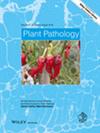基于天气的小麦和大麦赤霉病风险预测模型:综述
IF 2.4
3区 农林科学
Q1 AGRONOMY
引用次数: 0
摘要
镰刀菌头疫病(FHB)是世界范围内最具破坏性的作物病害之一,当开花期间天气条件有利时,会显著降低小麦和大麦等小谷物作物的产量和质量。此外,与fhb相关的真菌毒素严重影响全球食品和饲料安全。在花期附近使用杀菌剂控制FHB可减少FHB的视觉症状和相关真菌毒素的产生,从而降低与疾病相关的成本。然而,当天气条件不利于FHB的发生时,杀菌剂的应用可能是昂贵的,并且对环境不利。因此,只有在病原体存在且天气条件有利的情况下,才应少量使用杀菌剂。近几十年来,利用天气数据建立食物中毒风险模型发展迅速,在作物病害综合管理中发挥着重要作用。在这篇综述中,选择并详细描述了几种基于天气的FHB模型。这些模型是在全球范围内开发的,用于评估各区域/国家中食源性乙型肝炎流行的实时风险。这些模型大多是位点特异性的,可以预测FHB的发生率和严重程度、镰刀菌损伤的籽粒(FDK)以及脱氧雪腐镰刀菌醇(DON)水平等目视观察结果。该综述还强调了这些现有模型的局限性,包括它们的适用性狭窄,对高风险污染情况的准确性较低,以及某些因素的遗漏。还讨论了改进和增强预测能力的潜在途径,包括考虑其他疾病风险因素以及更广泛的品种。这些预测模型可以帮助生产者、监管机构和行业减轻潜在的食品和饲料安全和安全问题。本文章由计算机程序翻译,如有差异,请以英文原文为准。

Weather-based models for forecasting Fusarium head blight risks in wheat and barley: A review
Fusarium head blight (FHB) is one of the most devastating crop diseases worldwide, significantly reducing the yield and quality of small-cereal crops such as wheat and barley when favourable weather conditions exist during anthesis. Additionally, FHB-associated mycotoxins significantly impact global food and feed safety. Controlling FHB with fungicides applied near anthesis reduces visual FHB symptoms and associated mycotoxin production, thereby lowering disease-related costs. However, when weather conditions are unfavourable for FHB occurrence, fungicide application can be costly and environmentally undesirable. Thus, fungicides should be used sparingly only when the pathogen is present and weather conditions are favourable. Modelling of FHB risk using weather data has grown rapidly in recent decades and plays an essential role in integrated crop disease management. In this review, several weather-based FHB models are selected and described in detail. The models were developed globally for assessing the real-time risk of FHB epidemics in various regions/countries. Most of these models are site-specific and predict FHB visual observations such as the incidence and severity of FHB, Fusarium-damaged kernels (FDK), and also deoxynivalenol (DON) levels. The review also highlights the limitations of these existing models, including their narrow applicability, low accuracy for high-risk contamination situations, and omissions of certain factors. Also discussed are potential avenues for improvement and enhanced predictive capabilities including consideration of additional disease risk factors as well as a broader range of varieties. These predictive models can assist producers, regulatory agencies, and industry to mitigate potential food and feed security and safety concerns.
求助全文
通过发布文献求助,成功后即可免费获取论文全文。
去求助
来源期刊

Plant Pathology
生物-农艺学
CiteScore
5.60
自引率
7.40%
发文量
147
审稿时长
3 months
期刊介绍:
This international journal, owned and edited by the British Society for Plant Pathology, covers all aspects of plant pathology and reaches subscribers in 80 countries. Top quality original research papers and critical reviews from around the world cover: diseases of temperate and tropical plants caused by fungi, bacteria, viruses, phytoplasmas and nematodes; physiological, biochemical, molecular, ecological, genetic and economic aspects of plant pathology; disease epidemiology and modelling; disease appraisal and crop loss assessment; and plant disease control and disease-related crop management.
 求助内容:
求助内容: 应助结果提醒方式:
应助结果提醒方式:


